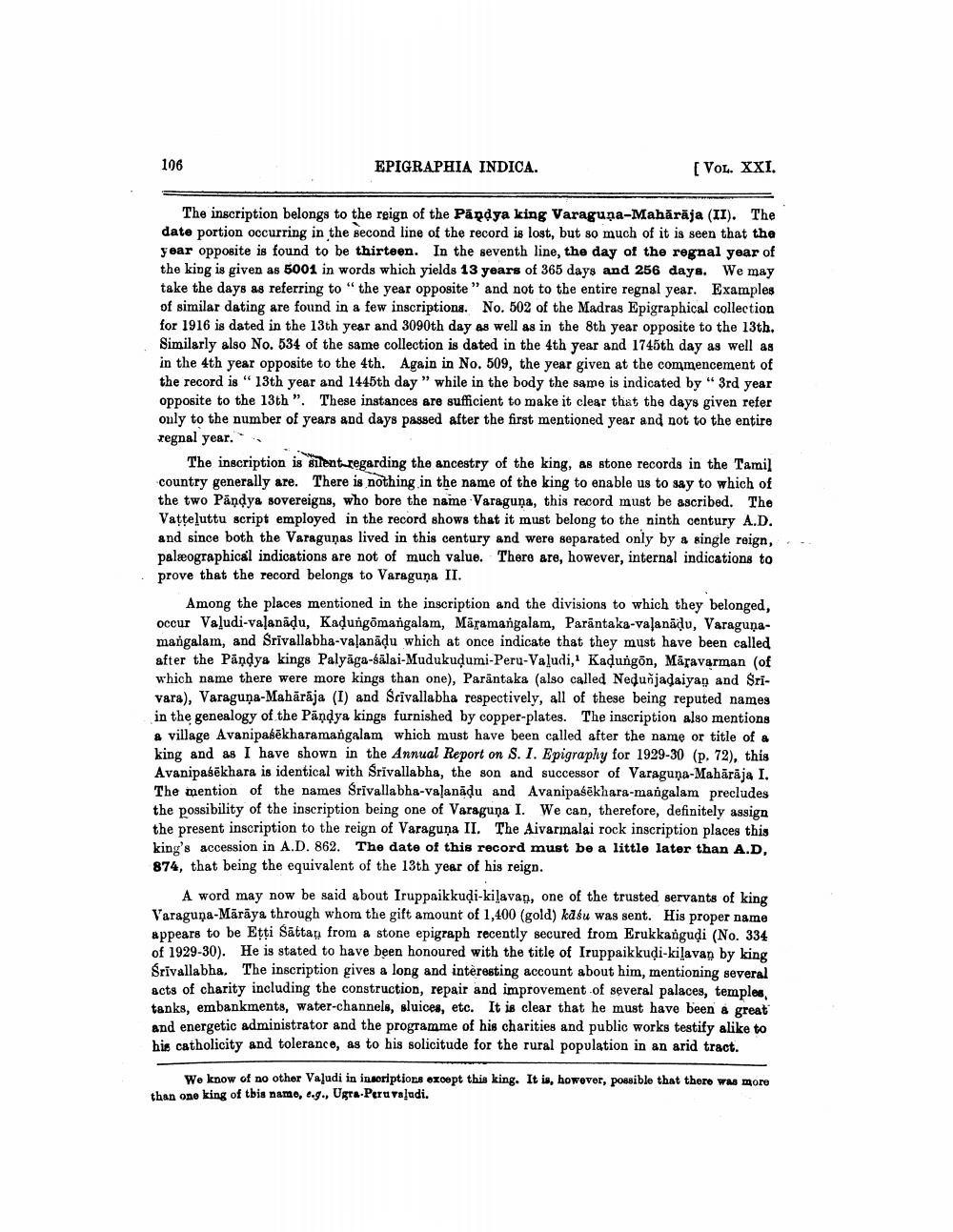________________
106
EPIGRAPHIA INDICA.
[VOL. XXI.
The inscription belongs to the reign of the Pandya king Varaguņa-Mahārāja (II). The date portion occurring in the second line of the record is lost, but so much of it is seen that the year opposite is found to be thirteen. In the seventh line, the day of the regnal year of the king is given as 5001 in words which yields 13 years of 365 days and 256 days. We may take the days as referring to "the year opposite " and not to the entire regnal year. Examples of similar dating are found in a few inscriptions. No. 502 of the Madras Epigraphical collection for 1916 is dated in the 13th year and 3090th day as well as in the 8th year opposite to the 13th. Similarly also No. 534 of the same collection is dated in the 4th year and 1745th day as well as in the 4th year opposite to the 4th. Again in No. 509, the year given at the commencement of the record is " 13th year and 1445th day" while in the body the same is indicated by " 3rd year opposite to the 13th ". These instances are sufficient to make it clear that the days given refer only to the number of years and days passed after the first mentioned year and not to the entire
segnal year.
The inscription is silent regarding the ancestry of the king, as stone records in the Tamil country generally are. There is nothing in the name of the king to enable us to say to which of the two Pandya sovereigns, who bore the name Varaguņa, this record must be ascribed. The Vatteluttu script employed in the record shows that it must belong to the ninth century A.D. and since both the Varaguņas lived in this century and were separated only by a single reign, ... palæographical indications are not of much value. There are, however, internal indications to prove that the record belongs to Varaguna II.
Among the places mentioned in the inscription and the divisions to which they belonged. occur Valudi-valanādu, Kadungomangalam, Māramangalam, Parāntaka-valanādu, Varaguņamangalam, and Srivallabha-valanādu which at once indicate that they must have been called after the Pandya kings Palyāga-Sālai-Mudukudumi-Peru-Valudi, Kadungon, Māravarman (of which name there were more kings than one), Parantaka (also called Neduñjadaiyan and Srivara), Varaguņa-Mahārāja (I) and Srivallabha respectively, all of these being reputed names in the genealogy of the Pandya kings furnished by copper-plates. The inscription also mentions & village Avanipasēkharamangalam which must have been called after the name or title of a king and as I have shown in the Annual Report on S. I. Epigraphy for 1929-30 (p. 72), this Avanipasēkhara is identical with Srivallabha, the son and successor of Varaguna-Mahārāja I. The mention of the names Srivallabha-valanādu and Avanipaśēkhara-mangalam precludes the possibility of the inscription being one of Varaguna I. We can, therefore, definitely assign the present inscription to the reign of Varaguna II. The Aivarmalai rock inscription places this king's accession in A.D. 862. The date of this record must be a little later than A.D, 874, that being the equivalent of the 13th year of his reign
A word may now be said about Iruppaikkuļi-kilavan, one of the trusted servants of king Varaguņa-Mārāya through whom the gift amount of 1,400 (gold) kasu was sent. His proper name appears to be Etti Sättag from a stone epigraph recently secured from Erukkangudi (No. 334 of 1929-30). He is stated to have been honoured with the title of Iruppaikkuļi-kilavan by king Srivallabha. The inscription gives a long and interesting account about him, mentioning several acts of charity including the construction, repair and improvement of several palaces, temples, tanks, embankments, water-channels, sluices, etc. It is clear that he must have been a great and energetic administrator and the programme of his charities and public works testify alike to his catholicity and tolerance, as to his solicitude for the rural population in an arid tract.
We know of no other Valudi in insoriptions ozoopt this king. It is, howover, possible that there was more than one king of this name, e.g., Ugra-Peru valadi.




